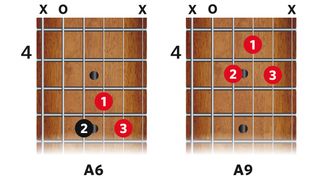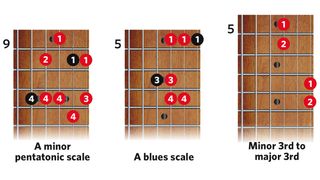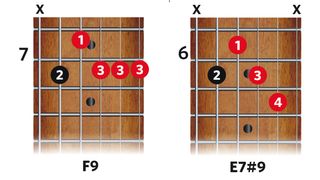Most of us know James Bay as a talented singer-songwriter. But James also plays a mean bit of blues guitar, and, when we asked him to jam he responded with an improv demonstrating touch, tone and feel beyond his years.
Inspired by James, this lesson will improve your rhythm playing in a I-IV-V blues progression. 'I-IV-V' means the chords are found on the first, fourth and fifth notes of the major scale (A, D and E, in the key of A).
James cut his teeth playing unaccompanied solo gigs so it's no surprise that his rhythm chops cover basslines, chords and melody - it's an exercise in filling out the sound.
Check out James' improv in our exclusive video and approach our lesson with your focus on ad libbing around the ideas shown here.
Note: The examples below are written in standard tuning (EADGBE). To play along with James in our video, tune a step down to DGCFAD.
1. Create a vamp on the root chord

James kicks off his improv with a simple chord played over the open fifth string before sliding the shape down two frets. This simple but clever idea hints at two chords (A6 and A9) at the same time and introduces a melodic vibe to the progression, too.
2. Walk into the IV chord

In the key of A major, D is the IV chord and James keeps the D interesting by 'walking' into a D7/F# chord via the lowest two notes on the sixth string: E and F. To keep things fresh he also improvises around two more D7 shapes.
3. Play a lead flourish

After ad libbing on the A and D chords James introduces a bevvy of lead flourishes - a great idea with an authentic vibe, and you can do the same with the scale shapes shown here. James also uses the staple blues trick of moving between minor and major 3rds.
4. Use dissonance on the V chord

The V chord is a crucial part of any I-IV-V blues progression, usually marking the start of the turnaround. Rather than staying on the E7 James briefly moves up to F9 for a harsher sound. E7#9 would do a similar job, too.
5. Use a turnaround to go back to the start

Instead of heading from the V chord straight back to the root it is common in blues to use a 'turnaround' - a run of chords or a melody that moves step by step back to the root. James does this by playing along the fourth string as the open fifth rings out.
6. Thirds time lucky

One key feature of James' songs is his use of compound 3rds (a 3rd plus an octave) in tracks like Let It Go, Scars and Craving. These Em and G chords are based on A- and Am-shape barre chords.

These are variations on the minor shape above and make use of an open third string. James often leaves out the sixth string in the D shape. Make up your own sequence with these shapes.
Don't Miss
James Bay talks Epiphone Centurys and 'blagging being a singer songwriter'

